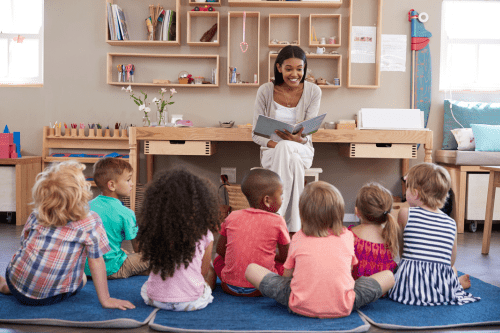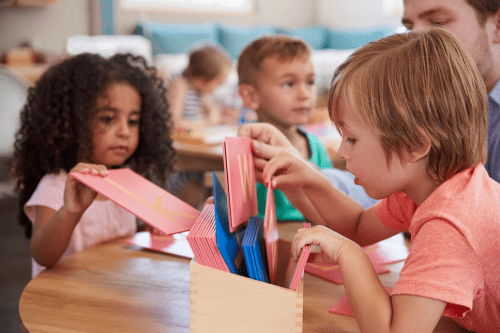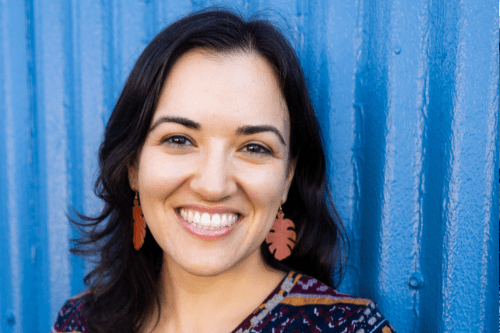Gabrielle Kotkov, Montessori educator and TESOL (Teaching English to Speakers of Other Languages) instructor, is the founder of Multilingual Montessori, a resource and inspiration for parents, caregivers, and teachers who are raising and educating multilingual children from a Montessori perspective. Gabrielle has a Master of Science in Child Studies and has taught in schools in New York City; London; Bologna and Catania (Sicily), Italy; and Austin, TX. She speaks English, Italian, French, and a bit of Spanish. In the following digital interview, Gabrielle shares her story and discusses language teaching and learning, offering advice and inspiration to those hoping to expose children to multilingualism.
Can you tell me a little bit about your personal and professional background and how you came to find Montessori and multilingual education?
Gabrielle:
I grew up as a monolingual English speaker in New York City, but I was always surrounded by peers who spoke other languages and I was always fascinated by languages. I studied Spanish in middle school and French in high school, then I decided to major in Italian in college and studied abroad in Siena and Bologna, Italy. After college, I got my certification in TESOL and then did a Fulbright scholarship in Catania, Sicily, where I taught English to Italian high school students.
 I then became more interested in teaching in early childhood settings and learned about Montessori education. After two years of working as an assistant in a Montessori school in Manhattan, I did my Montessori training in London, where I had the opportunity to observe and do student teaching at a French-English bilingual Children’s House. I really enjoyed seeing how a Montessori environment could support bilingualism, and vice versa. I worked as a lead guide in Montessori schools following my training, but I remained interested in multiple language acquisition in young children and how it intersected with Montessori, and I was always on the lookout for an opportunity to combine these two interests.
I then became more interested in teaching in early childhood settings and learned about Montessori education. After two years of working as an assistant in a Montessori school in Manhattan, I did my Montessori training in London, where I had the opportunity to observe and do student teaching at a French-English bilingual Children’s House. I really enjoyed seeing how a Montessori environment could support bilingualism, and vice versa. I worked as a lead guide in Montessori schools following my training, but I remained interested in multiple language acquisition in young children and how it intersected with Montessori, and I was always on the lookout for an opportunity to combine these two interests.
What was the impetus for starting Multilingual Montessori? How did it come to be?
Gabrielle:
During the summer of 2020, I was thinking about how Montessori and bilingual/multilingual education intersected, and found that there weren’t many resources covering this (rather niche) topic. I started the Multilingual Montessori Instagram account and website to share resources and connect with parents, caregivers, and educators who were also interested in this topic. I started the Multilingual Montessori Podcast a year later, and the rest is history!
What is the mission and vision of Multilingual Montessori? What do you hope to accomplish through the organization?
Gabrielle:
I hope to inspire both parents/caregivers and educators that multilingualism is very achievable and that any exposure we can give children to multiple languages will benefit them in many ways throughout their lives! I feel passionate about three aspects of this mission: the first is reassuring parents who speak a non-dominant language that speaking to their children in that language (or languages) is not doing them a disservice, but will in fact benefit them linguistically, developmentally, and also culturally and emotionally, especially if it is a family or heritage language. The second aspect I feel passionate about is providing resources to monolingual parents to learn a second language together with their child. (It’s very possible to raise a bilingual child even if you aren’t bilingual yourself!) And the third is to help Montessori educators, especially those in monolingual classrooms, to support their bilingual and multilingual students’ language development in all of their languages.
How does Montessori support multilingual education/parenting or vice versa?
Gabrielle:
 From everything that we know about the Absorbent Mind and the Sensitive Period for Language, the optimal time to introduce children to multiple languages is in the First Plane of Development, and many of the Montessori language materials that we use in Toddler and Primary environments for first language acquisition are applicable to second and third language acquisition as well.
From everything that we know about the Absorbent Mind and the Sensitive Period for Language, the optimal time to introduce children to multiple languages is in the First Plane of Development, and many of the Montessori language materials that we use in Toddler and Primary environments for first language acquisition are applicable to second and third language acquisition as well.
But that doesn’t mean that once children are in the Second Plane they can’t learn new languages! We can also look to Montessori’s understanding of the Reasoning Mind to support older children learning additional languages by talking to them about language and grammatical structures, playing games to memorize vocabulary, and learning the history and traditions of people who speak the language they’re learning.
What are some of the current projects you’re working on?
Gabrielle:
My biggest ongoing project is the Multilingual Montessori Podcast. I interview guests year-round and release 2 – 3 new episodes a month. I interview educators, parents, researchers, and other experts who have experience with Montessori and/or bilingualism and multilingualism. Many of my guests are parents raising bilingual or multilingual children, Montessori guides who have taught in bilingual classrooms or who are themselves multilingual, and adults who grew up speaking two or more languages. We talk about the intersection between language and identity, how to find balance in speaking two or more languages in a monolingual environment, and raising and teaching children from a Montessori perspective. I try to share a wide range of perspectives and expertise, and I hope that both parents and educators find the episodes informational and inspiring!
What future projects are on the horizon?
Gabrielle:
I’m very excited to be presenting at both the American Montessori Society (AMS) and Association Montessori Internationale (AMI) conferences in 2024! I’m also working on a longer course for AMS, together with another colleague, about multilingualism and Montessori. I’m looking forward to sharing those projects with fellow educators!
What advice do you have for bilingual Montessori educators and/or parents and caregivers?
Gabrielle:
Like with everything else in teaching and parenting, patience and giving yourself grace is key. There is no such thing as perfection in language teaching and learning, and any exposure children have to an additional language is valuable. Even if children are not fluent in a second or third language now, and even if they never become fluent in another language, they still get many developmental and socioemotional benefits from being exposed to other languages. Even something as simple as developing a basic awareness that people speak other languages throughout the world, and gaining an insight into another culture, can instill empathy and curiosity in children that stays with them for the rest of their lives.
Most importantly, it is never too early to introduce an additional language to children, and it is never too late. The best time is now!
Interested in writing a guest post for our blog? Let us know!
The opinions expressed in Montessori Life are those of the authors and do not necessarily represent the position of AMS.


